|
|
Post by akansan on May 7, 2009 14:04:06 GMT -5
Along with the 10" Frantom, I also picked up this 16" homemade saw. It's a hydraulic auto-feed, but I have no idea how this thing works. I also have no idea how this thing drains, as there doesn't appear to be any sort of drain on the box. Right now, the plan is to take the vice with the crossfeed off this guy and attach it to the saw that Curt was selling. However, I'd like to know how this hydraulic feed was supposed to work for curiosity's sake if nothing else. Vice - will probably need some tinkering to swap out with the other saw 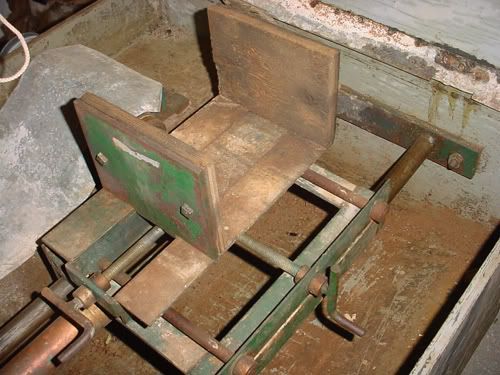 Control Valves 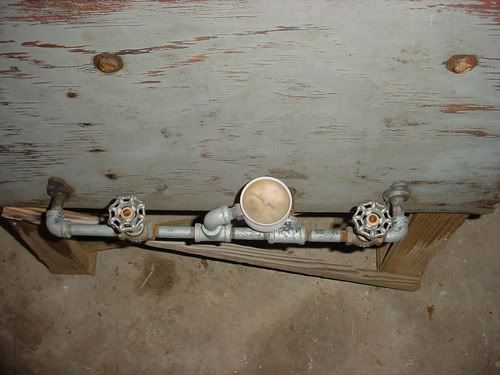 Left Spigot attaches to this  Right Spigot attaches to this  One tube goes to the hydrualic jack, the other  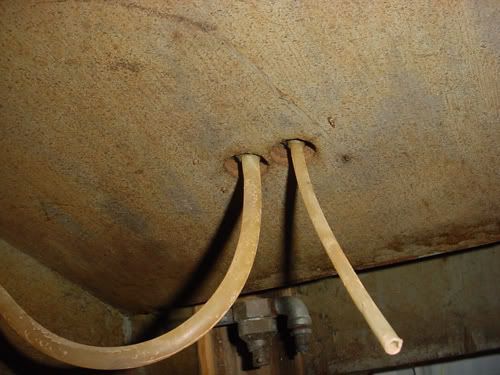 Picture of the main saw body 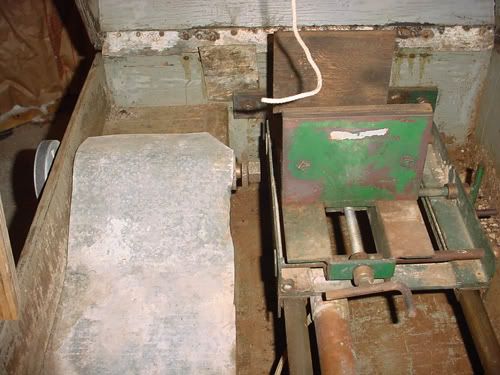 Anyway, for $100 I figure I at least purchased some good parts. Supposedly, this was built according to some plans that were published in the Lapidary Journal many years ago. The guy I bought it from bought it from someone who bought it from someone. Yeah, I know. Anyway, he had no idea. So I thought I'd bring it to you bright guys to see what you could figure out. Let me know if you need any other pictures.  |
|
|
|
Post by texaswoodie on May 7, 2009 14:49:12 GMT -5
Yup, sure is.
;D
Curt
|
|
Mudshark
fully equipped rock polisher
   Diplomacy is the art of saying 'Nice doggie' until you can find a rock. Will Rogers
Diplomacy is the art of saying 'Nice doggie' until you can find a rock. Will Rogers
Member since December 2008
Posts: 1,083
|
Post by Mudshark on May 7, 2009 15:18:24 GMT -5
I dont know how that hydraulic feed works but making a screw feed is not really difficult.I started my homemade 16 inch saw with a gravity feed and then converted it to screw feed.It makes sawing a lot more enjoyable.The parts can be purchased at most hardware stores and would take a few hours or less.If this sounds like something you want to do let me know and I can post some details.
Mike
|
|
|
|
Post by catmandewe on May 7, 2009 16:57:12 GMT -5
Hydraulic feed would be the way to go if you have all the parts for it.
The 2 valves and the gauge are how you adjust the pressure. One valve is a pressure valve, and the other valve is a bleed off valve, to release excess pressure. If you have a softer rock, it will cut faster because it is regulated by pressure not speed, thereby supposedly giving you a smoother cut.
Does the motor run a small hydraulic pump? There would have to be some kind of pump to create hydraulic pressure. I would see if I could get that to work before I would change to some other feed system, especially if all the parts are there.
Cool find!!
Tony
|
|
|
|
Post by akansan on May 7, 2009 17:18:27 GMT -5
Ah - so the valve on the left probably would attach to a hydraulic pump, correct? No pump came with the saw. The guy thought perhaps it actually hooked into a water system or possibly an air compressor (although, that would make it a pneumatic feed, right?).
|
|
|
|
Post by catmandewe on May 7, 2009 17:27:56 GMT -5
yep, air would be pneumatic and water or oil would be hydraulic.
Too bad it didn't come with all the parts, that would be cool to make work right.
Let us know what you do with it, I am curious.
Tony
|
|
|
|
Post by MrP on May 7, 2009 20:29:20 GMT -5
A couple of years ago I bought a saw that was set up just like that. I was made for using with water but every thing was shot because it hadn't been used for so long. I have a large air compressor so I reworked it for air. I love it. I Will see if I can get some good pics tomorow........MrP
|
|
|
|
Post by akansan on May 8, 2009 8:08:32 GMT -5
Mr P, that would be wonderful. I think I know the saw you purchase, as well.  |
|
|
|
Post by MrP on May 8, 2009 17:35:13 GMT -5
Ya I think you do remember. I had forgotten about that. I would say I am sorry but you know that it would just be lip service  As I said I converted mine to air instead of water. I see no reason why water wouldn't work. The old cylinder leaked a little so I didn't want water in the oil. 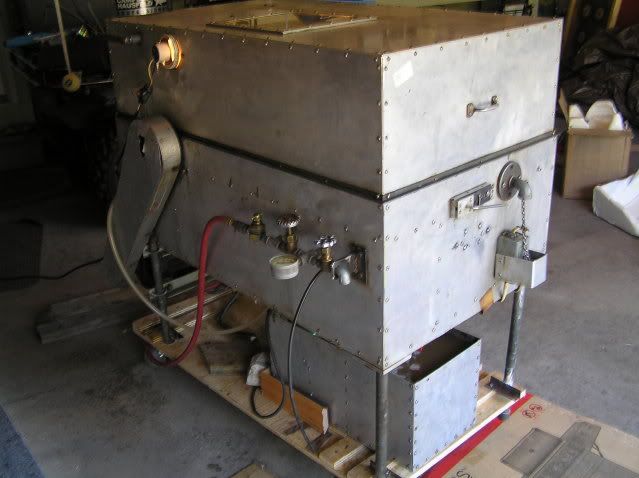 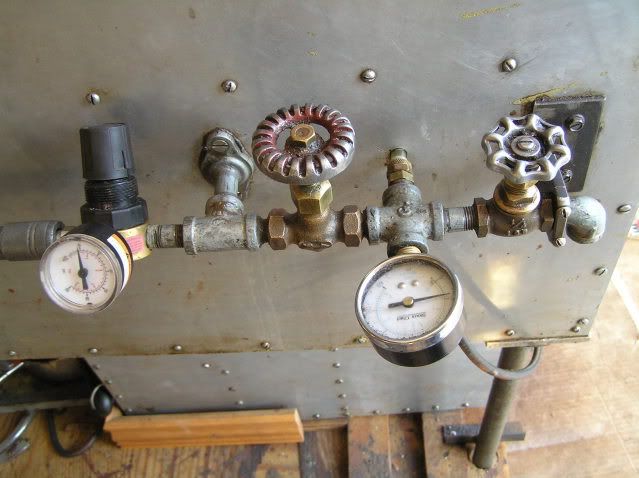  As you can see in the first pic I did use the regulator that came with it for awhile. I t didn't regulate very well, probably because it was for water, so I changed it out. I bought the regulator and Gauge through McMaster Carr on line. The red handled valve is the Shut-off and the other one has to be opened when you want to bring the carriage back. I had to make a new cylinder but it looks like you already have a good one. You might have to take it apart and see if the leathers are OK in it. if they are bad the air will leak past and you will not get the right pressure for cutting the rocks. You can get new leathers from McMaster Carr also. Hope this helps. Good luck. Any questions just ask......MrP |
|
agateer
off to a rocking start

Member since July 2012
Posts: 1
|
Post by agateer on Jul 25, 2012 9:29:13 GMT -5
Hey MrP and Akansan, I found myself in the same situation. Just bought a 20" built this same way last night for $100. Same deal, didn't come with a pump etc, owner had no idea when it was made how it worked etc. Anyone have any idea when they came up with the original plans for building these? I'd love to get my hands on them, apicture on the internet, or purchase a backissue of whatever lapidary magazine they were published in.
Akansan, did you ever get your saw running? Did you end up fixing up the hydraluics, converting to pnematics, or converting to threaded screw type?
MrP, the saw I bought uses a homemade PVC cylinder/piston to move the rock forward. Do you think I should switch up to a copper pipe one like yours? I would assume that you work at different pressures to regulate speed of rock going into blad depending on the hardness of the rock. Can you give me any idea what ballpark I'd be shooting for?
All the best,
Agateer
|
|
|
|
Post by jakesrocks on Jul 25, 2012 9:43:54 GMT -5
Those missing hydraulic pumps could probably be replaced with a junk yard power steering pump. Just make sure you use automotive hydraulic lines. You're dealing with a lot of pressure. A home made line coming apart under pressure will shower your whole shop in hydraulic fluid, and if it slaps you, it could cause injury.
|
|
|
|
Post by MrP on Jul 25, 2012 20:40:29 GMT -5
Agateer The reason I went to copper is because it had the best match for the piston size I wanted. I did some figuring and decided 2" would give me the best ratio for force on the rock at a low pressure. I use 10-15 lbs of air. It came with a 1.5" PVC cylinder. I used 2" copper and this - www.mcmaster.com/#piston-seals/=ikejde- for packing. I sure like how the saw works with air pressure because I can change the cutting speed with the pressure. Good Luck and welcome ..............MrP |
|
borock
starting to spend too much on rocks
 
Member since April 2011
Posts: 225
|
Post by borock on Jul 25, 2012 21:25:36 GMT -5
Mud shark ,I would like to see details if possible.Been wanting try and build a unit myself.
|
|
|
|
Post by Rockoonz on Jul 25, 2012 21:57:52 GMT -5
If the cylinder is made from PVC then it will be a Pneumatic. I have a saw made by the ROC company that is an air over oil pneumatic. The air pressure pushes the carriage and the oil is on the other end of the cylinder with a flow control that sets the maximum speed. 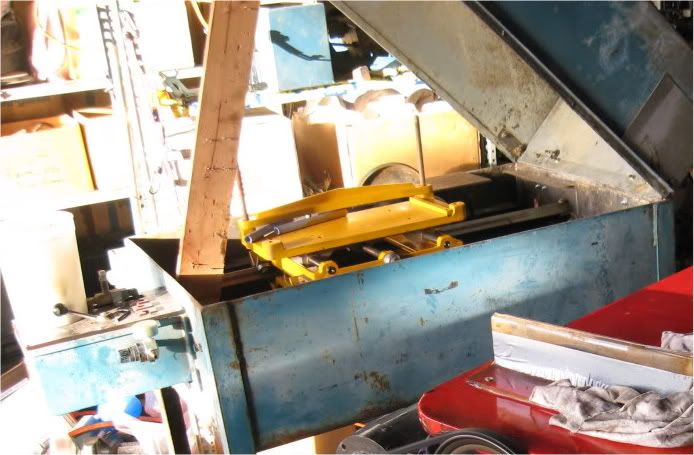 Works great but no auto shut off like a screw feed. I thought about the power steering pupm, but I would experiment with pulleys till it was spinning as slowly as possible and still developing pressure enough to cut. Lee |
|
|
|
Post by 3rdrockfromthefun on Jul 26, 2012 2:41:11 GMT -5
If I understood the part about regulation by pressure then I would definitely try and get it working exactly like it was built so that it does just that - regulate. What an awesome way to push rock - auto adjusts pressure of push according to the hardness of the rock. I would think that would also extend blade life considerably?
Sweet!
|
|
|
|
Post by Rockoonz on Jul 27, 2012 16:03:04 GMT -5
They don't adjust pressure or force, the speed is what will change dependant on the hardness and thickness of the rock. A calculator to translate hydrailic or pneumatic pressure in psi to force. www.knighthawksupply.com/calccylforce1.htmLee |
|
|
|
Post by billygoattreasures on Jan 27, 2022 1:06:43 GMT -5
If the cylinder is made from PVC then it will be a Pneumatic. I have a saw made by the ROC company that is an air over oil pneumatic. The air pressure pushes the carriage and the oil is on the other end of the cylinder with a flow control that sets the maximum speed.  Works great but no auto shut off like a screw feed. I thought about the power steering pupm, but I would experiment with pulleys till it was spinning as slowly as possible and still developing pressure enough to cut. Lee Oh my God man I have the same exact so I thought I was the only one. Holy shit I can’t believe I found it!! |
|
|
|
Post by Rockoonz on Jan 27, 2022 7:37:24 GMT -5
If the cylinder is made from PVC then it will be a Pneumatic. I have a saw made by the ROC company that is an air over oil pneumatic. The air pressure pushes the carriage and the oil is on the other end of the cylinder with a flow control that sets the maximum speed.  Works great but no auto shut off like a screw feed. I thought about the power steering pump, but I would experiment with pulleys till it was spinning as slowly as possible and still developing pressure enough to cut. Lee Oh my God man I have the same exact so I thought I was the only one. Holy shit I can’t believe I found it!! I see you're in Oregon. I sold the ROC to Michael Sage in Vancouver WA a few years ago, we have traded gear and stuff many times. If yours has the Swedish flag color scheme it is most certainly the same saw. The blue is the possibly original color. The yellow is powder coat safety yellow from a HF kit. If it is my old saw the crossfeed is line bored and has bronze bushings installed to fix the sloppiness it had when I got it. ROC made these saws and an automatic cabochon shaper when they were in business, no idea if there was anything else. A search would bring up an old ad for some machines back when I had it, but nothing now. |
|
kregg
off to a rocking start

Member since August 2024
Posts: 2
|
Post by kregg on Aug 27, 2024 15:41:34 GMT -5
Along with the 10" Frantom, I also picked up this 16" homemade saw. It's a hydraulic auto-feed, but I have no idea how this thing works. I also have no idea how this thing drains, as there doesn't appear to be any sort of drain on the box. Right now, the plan is to take the vice with the crossfeed off this guy and attach it to the saw that Curt was selling. However, I'd like to know how this hydraulic feed was supposed to work for curiosity's sake if nothing else. Vice - will probably need some tinkering to swap out with the other saw  Control Valves  Left Spigot attaches to this  Right Spigot attaches to this  One tube goes to the hydrualic jack, the other   Picture of the main saw body  Anyway, for $100 I figure I at least purchased some good parts. Supposedly, this was built according to some plans that were published in the Lapidary Journal many years ago. The guy I bought it from bought it from someone who bought it from someone. Yeah, I know. Anyway, he had no idea. So I thought I'd bring it to you bright guys to see what you could figure out. Let me know if you need any other pictures.  |
|
kregg
off to a rocking start

Member since August 2024
Posts: 2
|
Post by kregg on Aug 27, 2024 15:44:38 GMT -5
I'd love to know what issues of Lapidary Journal the plans came from because I have the same kind of saw! I just took it apart today after years of sitting in my backyard and it has what appears to be a homemade hydraulic ram driven by water hose pressure. The plunger is no longer working and I'm going to sweat the solder off the end and see what's inside in hopes of replacing the internals and soldering it back up. The ram is made from copper pipe and caps and has had nipples brazed or soldered into it. I'd love to see the original plans if anyone has a copy or can send me to the right place to get them.
Kregg
|
|